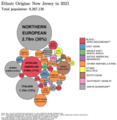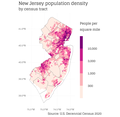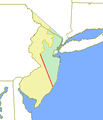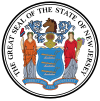The New Jersey Portal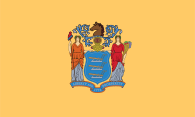 New Jersey is a state situated within both the Mid-Atlantic and Northeastern regions of the United States. It is the most densely populated of all 50 U.S. states, and is situated at the center of the Northeast megalopolis. New Jersey is bordered on its north and east by New York state; on its east, southeast, and south by the Atlantic Ocean; on its west by the Delaware River and Pennsylvania; and on its southwest by Delaware Bay and Delaware. At 7,354 square miles (19,050 km2), New Jersey is the fifth-smallest state in land area, but with close to 9.3 million residents as of the 2020 United States census, its highest decennial count ever, it ranks 11th in population. The state capital is Trenton, and the state's most populous city is Newark. New Jersey is the only U.S. state in which every county is deemed urban by the U.S. Census Bureau with 13 counties included in the New York metropolitan area, seven counties in the Philadelphia metropolitan area, and Warren County, part of the heavily industrialized Lehigh Valley metropolitan area. New Jersey was first inhabited by Paleo-Indians as early as 13,000 B.C.E., with the Lenape being the dominant Indigenous group when Europeans arrived in the early 17th century. Dutch and Swedish colonists founded the first European settlements in the state, with the British later seizing control of the region and establishing the Province of New Jersey, named after the largest of the Channel Islands. The colony's fertile lands and relative religious tolerance drew a large and diverse population. New Jersey was among the Thirteen Colonies that supported the American Revolution, hosting several pivotal battles and military commands in the American Revolutionary War. On December 18, 1787, New Jersey became the third state to ratify the United States Constitution, which granted it admission to the Union, and it was the first state to ratify the U.S. Bill of Rights on November 20, 1789. (Full article...) Selected article -
U.S. Route 1/9 Truck is a United States highway in the northern part of New Jersey that stretches 4.11 mi (6.61 km) from the eastern edge of Newark to the Tonnelle Circle in Jersey City. It is the alternate road for U.S. Route 1/9 that trucks must use because they are prohibited from using the Pulaski Skyway, which carries the main routes of U.S. Route 1/9. It also serves traffic accessing the New Jersey Turnpike, Route 440, and Route 7. The route is a four- to six-lane road its entire length, with portions of it being a divided highway, that runs through urban areas. From its south end to about halfway through Kearny, U.S. Route 1/9 Truck is freeway-standard, with access to other roads controlled by interchanges.
While the U.S. Route 1/9 Truck designation was first used in 1953, the roadway comprising the route was originally designated as an extension of pre-1927 Route 1 in 1922, a route that in its full length stretched from Trenton to Jersey City. U.S. Route 1/9 was designated along the road in 1926 and one year later, in 1927, this portion of pre-1927 Route 1 was replaced with Route 25 as well as with a portion of Route 1 north of the Communipaw Avenue intersection. Following the opening of the Pulaski Skyway in 1932, U.S. Route 1/9 and Route 25 were realigned to the new skyway. After trucks were banned from the skyway in 1934, the portion of Route 25 between Newark and Route 1 was designated as Route 25T. In 1953, U.S. Route 1/9 Truck was designated in favor of Route 25T and Route 1 along this segment of road. The portion of the truck route north of Route 7 is being rebuilt as part of a $271.9 million project that will replace the viaduct over St. Paul's Avenue. Construction, which started in late 2008, is expected to be complete in late 2012. Selected picture - Credit: Zeete Rutgers University is the largest institution for higher education in the state of New Jersey. It was originally chartered as Queen's College in 1766, and is the eighth-oldest college in the United States. New Jersey news'Related portalsSelected biography -George Thomas Reynolds (May 27, 1917 – April 19, 2005) was an American physicist best known for his accomplishments in particle physics, biophysics and environmental science. Reynolds received his PhD in physics from Princeton in 1943, writing a thesis of the propagation of shock waves. During World War II, he joined the United States Navy, and served with the Manhattan Project. He worked with George Kistiakowsky on the design of the explosive lenses required by the implosion-type nuclear weapon. He was involved in the investigation of the Port Chicago disaster, served with Project Alberta on Tinian, and was part of the Manhattan Project team sent to Hiroshima and Nagasaki to inspect the bomb damage. (Full article...)Did you know? -
General imagesThe following are images from various New Jersey-related articles on Wikipedia.
TopicsQuality content
CategoriesThings you can do
For more information on how you can help, see the WikiProject New Jersey. Associated WikimediaThe following Wikimedia Foundation sister projects provide more on this subject:
Discover Wikipedia using portals |











